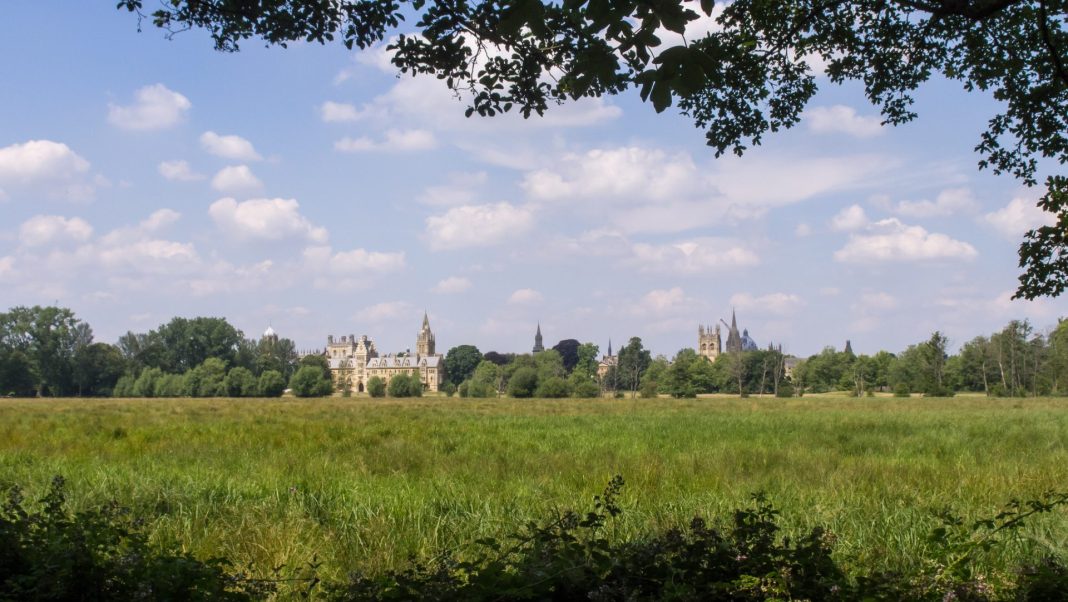As the sun emerges from its miserable winter enclave, so do students from their rooms, shedding the weighted blankets and hot water bottles of the colder months to enjoy the sun. As we flock to revel in these warmer months, here are some of the best natural spaces around Oxford.
OXFORD’S FAVOURITES
Port Meadow
Port Meadow is a picturesque location year-round, forming a gazing ground for herds of free-roaming cows and horses. Even when the plains are flooded, the meadows retain their scenic beauty, with swans milling through the long rushes and Ophelia-esque pools of duckweed and algae along the walking path. Through the gate and along the walk, you’ll also find a looping trail passing by a copse of mossy trees and Jack by the Hedge flowers.
The only caveat: if you do choose to have a picnic here, beware any inquisitive animals that may come passing by! My own snacks have stayed safe so far, although some of other meadow-enjoyers haven’t been quite so lucky.
Oxford Botanic Gardens
Oxford’s Botanic Gardens offers a sumptuous range of flora, with over 5000 different species; it’s a peaceful retreat from the action of the city centre. From water lily glasshouses and rock gardens to a literary-themed section and various geographical collections, the Botanic Gardens have something for any taste. The main garden is open from 10 am until 5 pm daily, with free entry for students if you show your Bod Card.
COLLEGE CLASSICS
Christ Church Meadows
Well known to students and tourists alike, Christ Church Meadows remains an iconic and reliable escape to the outdoors. The walk along the river or around the field makes for an easy break from being cooped up in the library – it’s open in daylight hours throughout the year, granting ample time to let the sun sink in.
Bounded by the rivers Cherwell and Isis, the meadows are also perfect for watching boats row by, with Boat House Island only a short walk away. For your own peace of mind, though, I would suggest finding a quieter path to walk on during Torpids season.
Fellows’ Garden, Merton College
Boasting a dedicated team of gardeners, Merton College’s Fellows’ Garden is a delight in all seasons – in spring, the lawns are lined with irises, almond trees, forget-me-nots and snowdrops, among many others. Robins and magpies hop their way through the bushes, and squirrels scamper their way around arching tree trunks.
While the lawn in the garden has ample space to sit and spread out a picnic blanket, the iconic Tolkien’s Table also offers stone benches to rest on, overlooking the garden on one side, and Christ Church Meadows on the other. A short walk away, on the other side of Merton, you’ll also find the sakura, daffodils and tulips in Grove, with benches dotted around to study, or simply indulge in the view.
Addison’s Walk, Magdalen College
Perhaps overshadowed by the Deer Park, this quaint, wooded walk around the back of the college is a lovely immersion in the beauty of nature. With various sitting spots, some carved from old tree trunks, dotting the way, it’s excellently suited for a slow amble along the river and through the trees. All varieties of flowers, from harebell and heather, line the path, across which the occasional heron or mallard might swoop.
HIDDEN TREASURES
Iffley Lock
Right by the canal, Iffley Lock was initially built as a weir to prevent flooding and ease the process of navigating the river. While it still serves this function now, it’s also a picturesque location of willows and stone bridges, perfect for a river-side wander. If you venture slightly further towards the highway strip, you’ll also find a gorgeous heath filled with shrubs and blossoming hawthorn – if you don’t mind the occasional rush of cars passing by, it’s a beautiful spot for picnics, flower-picking, and frolicking galore.
Wytham Woods
A prime bird-watching location for all avian enthusiasts, Wytham (pronounced why-tum) Woods is one of the most researched areas of woodland globally. When you step here, you’ll find yourself steeped in a long-abiding natural history: areas of the woods can be dated back to the last Ice Age. Spanning over 1000 acres, Wytham promises much to explore.
Bagley Wood
Saving what is, in my opinion, the best for last, any burden that the half hour bus trip from the city centre to Bagley Wood poses is dwarfed by the beauty and serenity of the space. Even on a misty, clouded morning, the nature reserve is full of whimsy: from the hanging bird feeders adorning the sides of tree trunks, to the abundance of bluebell patches and moss.
For those who delight in the quiet procession of life around them, Bagley Wood is also home to snails, slugs, frogs, and all assortments of little creatures, along with the occasional woodpecker and owl amongst the steady chirping of morning birds.
Amidst all the stress of tutorials, collections, and exams, it’s often easy to forget the world outside of Oxford’s academic halls. Hopefully, these suggestions can act as some guidance for your journey during Trinity to venture into the beautiful natural spaces around us – and maybe find some more of your own too!


